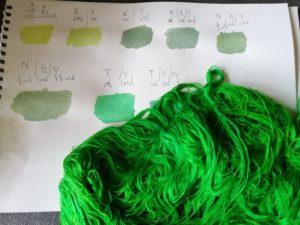I’ve spent the last few days dyeing silk yarn for a weaving project. I needed a very specific red and green, and two greys to give a neutral background.
I bought dye powders for all the colours, mixing them into a 1% stock solution that I used for immersion dyeing.
The two greys – charcoal and mid-grey – have turned out all right. Like black, grey dyes are difficult to mix. They tend to be made from very dark concentrations of blue, green or purple. The charcoal looks fine. It has a slight blue cast but is definitely a very dark grey. The mid-grey has a distinct mauve cast to it, but I’m hoping that will tone down as it dries – I’ve only just taken it out of the dye bath.
The red is good too, a bright pillar box red, which is just what I wanted, and different from the red dye I already had. The green however didn’t work at all. The dye powder I bought was called bright green but has turned out what I would call turquoise green. A lovely colour but not what I was looking for.
So I set to with my yellow and blue dye solutions to see if I could mix the right shade.
This involved mixing yellow with one of the blues in varying proportions and painting samples of the resulting colour onto white paper. The yellow turned out to be surprisingly dominant in 50/50 mixes with both blue and navy, and the navy was giving the wrong shade anyway, too olive.
The one I went with is the bright green in the centre of the bottom row, made from a 50/50 mix of yellow and turquoise. I would have liked a slightly darker colour, but actually I’m pleased with the finished dyed yarn.
It will stand out well next to the bright red and white in the pattern and should look good against the two greys.
I had forgotten how much fun it is to spend time mixing dye colours like this. Most of the dyeing I do is rainbow dyeing where I paint dyes onto the yarn and let them spread and blend to mix the colours. Maybe I’ll do more immersion dyeing in the future. I should certainly spend a few days mixing samples and making colour charts.



